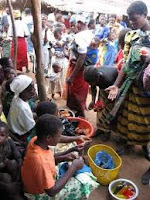A new book published shows how poor
urban communities across Africa and Asia have developed powerful new
approaches that have enabled millions of people to get better housing
and services, and —beyond this
— social justice and inclusion in political processes.
Their efforts and experiences stand in
stark contrast to the images of popular protest that have erupted in
large cities – as in Egypt and Brazil – in recent months. And as the
book’s authors note, these
quieter, more patient approaches to the problems of poverty and
injustice appear more likely to bring benefits in the long-term.
Reducing Urban Poverty in the Global South
by David Satterthwaite and
Diana Mitlin shows that unlike the street protests that capture media
attention, the people living in the “slums” of Africa and Asia realised
that their realties required a different way of
doing politics.
“Social movement leaders observed the
lack of progress in the post-independence period and decided that they
had re-design their strategies to increase the likelihood that equitable
and inclusive cities
were to be part of the political agenda,” says Dr Mitlin.
“They rejected demonstrations and
public protest because they knew that such a critical mass could not be
held on the streets for long – but had to return to livelihood
struggles,” she adds. “They rejected
revolutionary change – and contesting the seat of government – because
they recognised that history shows that those who secure such seats
rapidly join the political elites. And they recognised that there was
little point in making claims and defining entitlements
to a set of urban development policies which have delivered little in
terms of pro-poor development.”
Instead, an alternative approach has
emerged simultaneously in diverse countries over the past 20 years as
groups of low-income urban citizens from informal settlements have
joined forces to develop their
own solutions to previously intractable urban development problems.
Through less confrontational tactics
than mass protests, these groups have ensured that governments recognise
the urban poor for what they are — legitimate citizens able to sit
around the table with mayors
and ministers alike to determine new development options and help
implement them.
As a result millions of urban
residents are now organized in neighbourhood associations that come
together in city federations to negotiate with local government for
financial redistribution and investment
capital, alongside pledging their own time and effort in improving their
localities.
The book begins by discussing the most
widely-used conventional approaches to urban development, and explores
the ways in which these have been used by a range of development
agencies including national
and local government, and civil society.
The authors then describe the
alternative approach that has emerged, illustrating this with five case
studies of programme interventions that have adopted similar strategies
to address urban poverty and
advance the cause of the urban poor. These include international funds
that support their priorities and are accountable to them.
“These show the capacities of urban
poor organizations and federations not only to develop far more
effective solutions in dozens of countries but also to work with local
governments to do so at scale,”
says Dr Satterthwaite.
The final two chapters analyse the
approach and its underlying politics – and look forward to what this
means for action to address urban poverty in towns and cities of the
global south in the 21st century.
The new book, published by Routledge,
is the sequel to one Mitlin and Satterthwaite wrote in 2012. The
previous volume argued that governments and aid agencies have failed to
tackle urban poverty because
they have failed to understand it (see
Book challenges policymakers with new portrait of urban poverty).

No comments:
Post a Comment